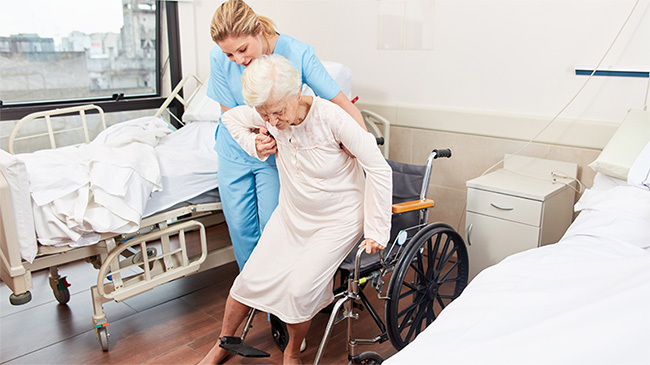Best practice: How to get a patient out of a wheelchair

Chair scales are a popular choice for weighing patients in care homes, nursing homes and hospitals. We are focusing on how to get a patient out of a wheelchair or chair scale safely.
Chair scales allow a patient unsteady on their feet to be weighed easily and comfortably. And, the scale can be taken to the patient - wherever they are in the home or hospital.
However, getting a patient into a chair scale - like with a standard wheelchair - requires planning and care. When moving a patient it is important to observe correct moving and handling policies dependant on the condition of the patient. Firstly a thorough risk assessment should be completed to ensure there is no risk of causing injury or discomfort to the patient.
Patient risk assessment
Risk of injury for physically dependent or unwell patients can vary from injuries caused by falling, or sustained back injuries due to repeated mishandling over time.
You may use the FIM measurement tool to ascertain the level of patient independence based on a score of 1-7. The scoring can be measured as per the table below:

Patient dignity
In addition to safety risks, there is also a consideration to be made regarding dignity and comfort of the patient. According to The Handling of People 5th Edition a 10 point likert scale is best practice. Studies found that ‘When patients are handled inappropriately it causes pain and discomfort, the resultant associated defence reactions within their physical body (muscular contractions, respiratory blocking, reactions of start or withdrawal) can be seen. People deserve to be respected physically and emotionally’.[1]
Once risk to the patient is suitably assessed, you can decide the best method for lifting the patient in line with your moving and handling procedure. For example a sitting to standing lift with handling belt, for a moderate dependency patient FIM 4 (as per table above); two carers are usually required to help lift the patient once in a seated position on the scale.
- The patient should be verbally encouraged to move forward to the edge of the chair and lean forward to initiate the stand.
- If the patient cannot move their own hips to the edge of the seat then one handler may assist by kneeling in front of the patient and ask them to to rock from one hip to another. The handler can apply pressure to move the raised hip forward and repeat until the patient is in the desired position.
- The handler then places the belt around the patient and secures.
- Standing either side of the patient, the handlers then encourage the patient to place their hands on the arms of the chair. If this is not possible the patient may take the handlers palms.
- The handler faces the direction of the movement and places their nearest arm to the person’s back and firmly grasps the handle of the belt.
- The handler then requests the patient lifts their head to initiate the lift.
- The handler then uses the handling belt to assist the lift to standing.
*All steps are guidelines noted in The Handling of People 5th Edition pages 130- 131
Finally for your own safety when lifting, NHS.co.uk suggest you make sure you:
- never lift above shoulder height
- keep your feet stable
- have a firm hold
- keep any weight close to your body
- keep your back straight and bend your knees
- lift as smoothly as possible
Weighing physically dependent patients is always a tricky procedure often requiring two or more carers to assist in lifting a patient in or out of a chair scale. Marsden always search for solutions that will aid the healthcare professionals to deliver the best care and provide the greatest comfort for the patient.
We have been developing a new product that will simplify the process of weighing patients who have trouble standing. With the right training our new scale will enable a single carer to ascertain an accurate weight.
To view our full range of chair scales click here, or for further information contact our team on +44 (0) 1709 364 296.
- Glaude D (2002) Introduction to Haptonomy, Veldman F (2001) Confirming affectivity; the dawn of human life. The International Journal of Prenatal Psychology and Medicine Vol.6 no.1, (1994) pages. 11-26